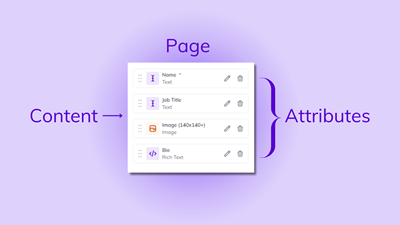Understanding Content Modeling with Structured Content


As the amount of digital content continues to explode, it's becoming increasingly important to understand how to structure it effectively. This makes structured content essential in today's digital landscape– where content needs to be adapted and reused across different channels and platforms.
Without a solid content modeling strategy, you'll be drowning in a sea of disconnected content, making it difficult to maintain consistency and coherence across your digital presence.
Content modeling, the practice of defining the types of content and the relationships between them, is key to creating structured content that can be easily managed, reused, and repurposed.
In this article, we'll explore the basÇics of content modeling and show you how structured content can streamline your content creation process and improve the user experience for your audience.
What Is Content Modelling?
Content modeling is the process of defining the structure and relationships between different types of content, which allows for the creation of structured and flexible digital content.
At its core, content modeling is about organizing and managing content in an efficient, effective, and scalable way.
The goal of content modeling is to break down digital content into its constituent parts, such as images, text, video content, and metadata, and then organize those parts into a structured system that can be easily managed and reused.
This approach helps to create modular content, which means it can be used across multiple channels and platforms without losing its integrity or meaning.
At a more technical level, content modeling involves creating a content model, which is essentially a blueprint or framework that outlines the different types of content and how they relate to each other.
This model can take different forms, depending on the organization's or project's specific needs, but it generally includes elements like content types, fields, and taxonomies.
Let's say you work for a large e-commerce company that sells a wide variety of products, from electronics to clothing.
To effectively manage and organize the vast amount of digital content associated with each product, you might create a content model that defines the structure and relationships between different types of content.
For example, your content model might include:
- A product content type that includes fields for product name, description, price, and images.
- A category taxonomy that includes categories like electronics, clothing, and home goods.
- A brand taxonomy that includes brands like Samsung, Nike, and KitchenAid.
- A review content type that includes fields for the reviewer's name, rating, and comments.
With this content model in place, you can easily create and manage digital content for each product, including product pages, category pages, and search results. You can also create structured data that can be used across multiple channels, such as social media or email marketing campaigns.
Content types refer to the different types of content that will be created, such as articles, product descriptions, or user profiles. Fields are the pieces of information that comprise each content type, such as a headline, body text, or author name. Taxonomies are the categories or labels that are used to organize and classify content, such as tags or categories.
By creating a well-designed content model, organizations can ensure that their digital content is consistent, scalable, and easy to manage.
This approach helps to streamline content creation, reduce errors, and improve the user experience for audiences across different platforms and channels.
Creating a Content Model
Creating a content model involves defining the structure and relationships between different types of content to create a framework for managing digital content.
It starts with understanding the business requirements, goals, and the audience's needs and expectations.
Understanding the Business Requirements and Goals
Before creating a content model, it's essential to understand the business requirements and goals. This means identifying the types of content needed, the channels and platforms where the content will be published, and the desired outcomes.
The content model should align with the organization's overall business strategy and support its goals.
To understand the business requirements and goals, organizations can conduct a content audit to assess their current content and identify any gaps or opportunities.
They can also analyze their competitors' content and industry trends to determine what type of content resonates with their target audience.
Identifying Content Types and Fields
The next step is to identify the different types of content that will be created and the fields that make up each content type. This can include text, images, videos, metadata, and more.
For example, if an organization is creating a content model for a product catalog, it may identify product descriptions, images, pricing, and specifications as the different types of content.
The fields for each type of content may include product name, SKU, product category, manufacturer, product features, and more.
Organizations can use various techniques to identify content types and fields, such as conducting user research, analyzing competitor content, and working with subject matter experts.
Organizing Content Using Taxonomies
Organizing content using taxonomies is a crucial step in content modeling. Taxonomies are classification systems that help categorize and organize content. This can include categories, tags, or any other labeling system that makes sense for the content.
For example, if an organization is creating a content model for a blog, they may use categories such as "Technology," "Marketing," and "Business" to organize their blog posts.
They may also use tags such as "SEO," "Social Media," and "Content Strategy" to further categorize the content.
Organizations can use various techniques to create taxonomies, such as conducting card sorting exercises with users, analyzing competitor taxonomies, and working with subject matter experts.
Benefits of Structured Content
Structured content offers several benefits for organizations looking to create, manage, and distribute digital content efficiently. Here are some of the key advantages:
Reusability of Content
Structured content allows organizations to create content once and reuse it across multiple channels and platforms. This means that instead of creating new content for each channel, organizations can repurpose existing content, saving time and resources.
For example, a product description created for an e-commerce website can be repurposed for use in a product catalog, product presentation video, or a mobile app. This not only saves time but also ensures consistency in messaging and branding across different channels.
Consistency in Branding and Messaging
Structured content ensures consistency in branding and messaging across different channels and platforms. By defining content types, fields, and taxonomies, organizations can establish a clear structure for their content, ensuring that it aligns with their brand voice and tone.
For example, a structured content approach can help ensure that a company's product descriptions have a consistent format and style, regardless of the platform or channel they are published on.
This consistency in branding and messaging helps to build trust with audiences and reinforces the organization's brand identity.
Scalability
Structured content allows organizations to scale their content creation and distribution efforts. By creating a content model that is flexible and scalable, organizations can easily add new content types and fields as needed without having to start from scratch.
For example, a structured content approach can help an e-commerce company easily add new product categories or product features to its catalog without having to create a new content model each time.
This scalability ensures that the organization can keep up with changing business needs and audience expectations.
Time and Cost Savings
Structured content can help organizations save time and money by streamlining content creation, reducing errors, and improving efficiency. By defining a clear content model, organizations can create content faster, with fewer errors, and distribute it across multiple channels more efficiently.
For example, a structured content approach can help a marketing team create social media posts faster by using pre-defined content types and fields.
Implementing Structured Content
Implementing structured content can present several challenges, but with the right approach and tools, organizations can reap the benefits of this approach.
Here's what you need to know:
Challenges of Implementing Structured Content
One of the biggest challenges of implementing structured content is getting stakeholders on board with the new approach.
This may involve educating content creators and decision-makers on the benefits of structured content and the changes that will be required in their workflows and processes.
Another challenge is ensuring the content model is flexible enough to accommodate future changes and updates. Organizations may need to invest in tools and platforms that allow for easy customization and scalability.
Also, migrating existing content to a structured content model can be a significant challenge, especially if the content is stored in multiple formats and locations.
Careful planning and execution are required to ensure that content is migrated correctly and that it retains its quality and consistency.
Best Practices for Implementing Structured Content
To implement structured content successfully, organizations should follow some best practices, including:
Start with a clear content strategy
Before implementing structured content, organizations should define their content goals, target audiences, and desired outcomes. This will help ensure that the content model is aligned with the organization's objectives and meets its audiences' needs .
Involve stakeholders from the outset
To ensure buy-in from stakeholders, involve them in creating the content model. This may involve conducting workshops or focus groups to gather input and feedback.
Define clear content types, fields, and taxonomies
A clear and well-defined content model is essential for structured content. This includes defining content types, fields, and taxonomies that align with the organization's content goals and target audiences.
Choose the right tools and platforms
To implement structured content, organizations will need to invest in tools and platforms that support this approach. This may include content management systems (CMS), digital asset management (DAM) systems, or other specialized tools.
Tools and Platforms for Structured Content
Several tools and platforms are available to support structured content, including:
Content Management Systems (CMS)
CMS platforms like Drupal, WordPress, and Sitecore offer tools for creating and managing structured content.
These systems allow organizations to define content types, fields, and taxonomies and to create content templates that ensure consistency and quality.
Digital Asset Management (DAM) Systems
DAM systems like Widen Collective, Bynder, and Brandfolder provide tools for organizing and distributing digital assets.
By storing assets in a central location, these systems ensure that content creators have access to the latest versions of images, videos, and other media.
Headless CMS
Headless CMS platforms like Agility provide a decoupled approach to content management, separating the content creation and delivery layers.
This approach allows organizations to create content once and distribute it across multiple channels and platforms without being tied to a specific front-end framework.
Jump Into Content Modelling and Structured Content Now
So there you have it, a deep dive into the world of content modeling and structured content. By now, you should have a solid understanding of how to create a structured content model that can help you streamline your content creation process and ensure consistency across all your channels.
Remember, the key is to always keep your audience in mind and create content that is both informative and engaging. With these tips in mind, you'll be well on your way to creating content that stands out and makes a lasting impact.

About the Author
Andre Oentoro is the founder of Breadnbeyond, an award-winning explainer video company. He helps businesses increase conversion rates, close more sales, and get positive ROI from explainer videos (in that order).
Twitter: @breadnbeyond
Email: andre@breadnbeyond.com
LinkedIn: Andre Oentoro
View Related Resources

What's the difference between content architecture and message architecture?

5 Common Mistakes Made When Developing the Content Architecture for a Site

